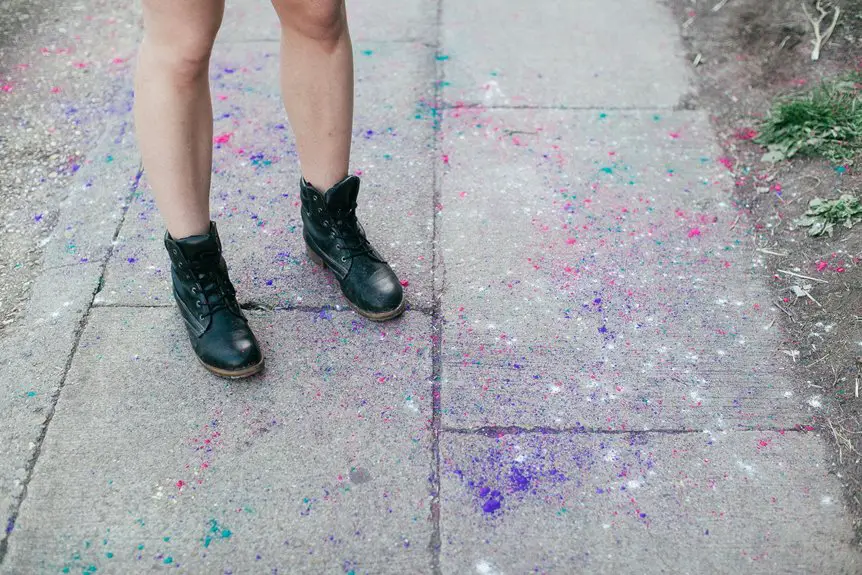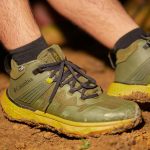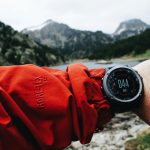You might need to apply additional waterproofing spray on your Gore-Tex boots when their durable water repellent (DWR) coating wears off and water stops beading on the surface. This spray helps restore water resistance without harming breathability, especially as wear and dirt reduce effectiveness over time. Using the right type of spray guarantees your boots stay comfortable and dry longer. If you want to understand how to identify wear and properly care for your boots, keep exploring these essential tips.
Table of Contents
Key Takeaways
- Gore-Tex boots come waterproof but may need additional spray as the Durable Water Repellent (DWR) coating wears off over time.
- Waterproofing sprays restore water beading and help maintain breathability without damaging the Gore-Tex membrane.
- Apply waterproofing spray only on clean, dry boots to effectively rejuvenate the protective outer layer.
- Signs for extra waterproofing include water no longer beading, fabric darkening, or feeling damp after light exposure to moisture.
- Avoid heavy oil or solvent-based sprays that can harm the Gore-Tex membrane and reduce boot performance.
How Gore-Tex Technology Works
Although it might seem like magic, Gore-Tex technology works by using a unique membrane that’s both waterproof and breathable.
When you wear Gore-Tex boots, this membrane blocks water from entering, so your feet stay dry even in wet conditions. At the same time, it allows moisture vapor—like sweat—to escape, keeping your feet comfortable and preventing overheating.
Gore-Tex boots keep your feet dry by blocking water while letting sweat escape for lasting comfort.
This balance is essential because it stops water from soaking in while letting your feet breathe. You don’t have to worry about water pooling inside the boots, but you also won’t feel trapped in a damp environment.
The membrane’s microscopic pores are small enough to block liquid water but large enough to let vapor pass through, providing an effective barrier against the elements without sacrificing breathability or comfort.
The Role of Waterproof Membranes in Boots
You rely on waterproof membranes like Gore-Tex to keep water out while letting your feet breathe.
Understanding the difference between water resistance and true waterproofing helps you choose the right boots.
You’ll also want to take into account how factors like wear and care impact the membrane’s durability over time.
Gore-Tex Membrane Functionality
Because moisture can ruin both comfort and durability, the Gore-Tex membrane plays an essential role in keeping your boots waterproof while allowing sweat to escape.
This thin, breathable layer has microscopic pores small enough to block water droplets but large enough to let water vapor pass through. When you’re active, sweat generated inside the boot vaporizes, and the membrane lets it out, preventing soggy, uncomfortable feet.
At the same time, it stops external water from seeping in, so your boots stay dry in wet conditions. This dual function means you don’t have to sacrifice breathability for waterproofing.
Understanding how the Gore-Tex membrane works helps you appreciate why it’s a reliable choice for outdoor footwear, especially if you want dry, comfortable feet during your adventures.
Water Resistance vs. Waterproof
The Gore-Tex membrane’s ability to block water while letting sweat escape highlights the difference between water resistance and waterproofing in boots. When you choose boots, understanding this distinction helps you pick the right protection.
| Feature | Description |
|---|---|
| Water Resistance | Repels light moisture, not fully sealed |
| Waterproof | Completely blocks water penetration |
| Breathability | Allows sweat vapor to escape |
| Gore-Tex Role | Provides waterproofing with breathability |
Water-resistant boots are fine for light rain or snow, but if you’re trekking through deep puddles or wet terrain, waterproof boots with Gore-Tex membranes keep your feet dry and comfortable. The membrane’s design balances blocking water and letting moisture out, preventing soggy feet and overheating. So, you get true waterproofing without sacrificing breathability.
Membrane Durability Factors
Although Gore-Tex membranes provide excellent waterproofing, their durability depends on how you use and care for your boots.
Constant abrasion, exposure to dirt, and harsh conditions can wear down the membrane over time. If you frequently trek through rough terrain or muddy areas, your boots will face more stress, potentially compromising their waterproof layer.
Proper cleaning and drying help maintain the membrane’s effectiveness. Avoid using harsh chemicals or high heat, which can damage the membrane.
Applying a suitable waterproofing spray on the outer fabric can also protect the membrane by repelling water and dirt, reducing wear.
Factors That Affect Gore-Tex Boot Waterproofing
When you rely on Gore-Tex boots to keep your feet dry, several factors influence how well they perform. Understanding these can help you maintain their waterproof integrity.
- Wear and Tear – Frequent use and abrasion can damage the outer materials, compromising waterproofing.
- Dirt and Debris – Mud and grime clog the membrane, reducing breathability and water resistance.
- Improper Cleaning – Using harsh detergents or skipping cleaning can degrade the membrane’s effectiveness.
- Seam Integrity – Worn or damaged seams allow water to seep through, bypassing the membrane entirely.
When Additional Waterproofing Spray Can Help
If you notice water starting to seep through your Gore-Tex boots despite proper care, applying an additional waterproofing spray can restore their protective barrier.
Over time, dirt, wear, and exposure to harsh conditions can degrade the durable water repellent (DWR) coating on your boots’ outer fabric. When this happens, water no longer beads up and rolls off, increasing the chance of moisture penetration.
Using a waterproofing spray can rejuvenate the DWR finish, enhancing water resistance without compromising breathability. It’s especially helpful if you often hike in wet environments or if your boots have been exposed to prolonged moisture.
Keep in mind, though, that sprays work best when applied to clean, dry boots to guarantee even coverage and maximum effectiveness.
Types of Waterproofing Sprays Compatible With Gore-Tex
You’ll want to choose waterproofing sprays with ingredients that won’t damage your Gore-Tex membrane.
Make sure to follow the recommended application frequency to maintain effectiveness without overdoing it.
Let’s look at which sprays work best and how often you should use them.
Spray Ingredients Compatibility
Choosing the right waterproofing spray is essential to maintaining your Gore-Tex boots‘ performance. Not all sprays are compatible with Gore-Tex membranes, so you need to focus on ingredients that preserve breathability and water resistance without clogging pores.
Here are four key ingredient types to look for:
- Fluorocarbon-based sprays – Offer durable water repellency while maintaining breathability.
- Silicone-based sprays – Provide good water resistance but can reduce breathability if overused.
- Wax-based sprays – Enhance waterproofing but may require careful application to avoid stiffness.
- Water-based sprays with DWR (Durable Water Repellent) – Eco-friendly and effective, preserving membrane function.
Avoid sprays with heavy oils or solvents that can damage the Gore-Tex membrane and reduce its effectiveness.
Application Frequency Guidelines
Regularly applying the appropriate waterproofing spray keeps your Gore-Tex boots performing at their best.
Generally, you should reapply the spray after every 3 to 6 months of regular use or whenever you notice water no longer beads up on the surface. If you often hike in wet or muddy conditions, consider applying it more frequently, perhaps every couple of months.
Always use sprays compatible with Gore-Tex, like those specifically labeled for breathable membranes, to maintain their waterproof and breathable qualities.
Avoid heavy applications; a light, even coat is sufficient.
After cleaning your boots, wait until they’re dry before spraying to guarantee proper absorption.
How to Properly Apply Waterproofing Spray on Gore-Tex Boots
Before applying waterproofing spray on your Gore-Tex boots, make sure they’re clean and dry to guarantee the spray adheres properly.
Dirt and moisture can prevent the spray from bonding, reducing effectiveness.
Here’s how to apply it correctly:
- Hold the spray about 6-8 inches from the boot surface for even coverage.
- Apply a light, consistent mist rather than soaking the boots to avoid clogging the membrane.
- Allow the boots to air dry completely in a well-ventilated area, away from direct heat or sunlight.
- Apply a second coat if you plan to use the boots in extremely wet conditions for enhanced waterproofing.
Following these steps will help maintain your Gore-Tex boots’ breathability and keep your feet dry.
Signs Your Gore-Tex Boots Need Extra Waterproofing
You’ll know your Gore-Tex boots need extra waterproofing when water stops beading on the surface and starts soaking in.
If you notice the fabric looks darker or feels damp after light exposure to water, it’s a clear sign the waterproof layer is wearing off.
Acting quickly can keep your boots dry and extend their life.
Water Beading Loss
Water beading is a clear indicator that your Gore-Tex boots are still effectively repelling moisture. When water droplets form into beads and roll off the surface, it means the Durable Water Repellent (DWR) coating is intact.
However, once you notice water no longer beads but instead soaks in or spreads out, it’s time to contemplate extra waterproofing. Here are signs of water beading loss:
- Water flattens and absorbs quickly instead of forming droplets.
- Your boots feel damp on the outside after light rain or snow.
- You see dark patches indicating moisture saturation on the surface.
- The boots lose their usual slick, repellent texture.
Addressing water beading loss early helps maintain your boots’ waterproof performance.
Fabric Saturation Indicators
Although your Gore-Tex boots are designed to keep moisture out, fabric saturation can still occur over time, signaling that extra waterproofing is necessary. You’ll notice the fabric feels heavier or damp inside after exposure to wet conditions, even if the exterior looks dry. Additionally, water may start soaking through instead of beading off. These signs mean the breathable membrane is compromised and needs reinforcement.
Here’s how to identify saturation clearly:
| Indicator | What It Means |
|---|---|
| Damp Interior | Water has penetrated the fabric |
| Reduced Water Beading | Outer layer losing repellency |
| Heavier Boots | Fabric absorbing moisture |
If you spot these, it’s time to reapply a waterproofing spray to restore protection.
Common Misconceptions About Gore-Tex Waterproofing
Many people assume Gore-Tex boots stay completely dry no matter what, but that’s not always true.
While Gore-Tex membranes are excellent at repelling water, they do have limits and require proper care.
Here are some common misconceptions you should know:
- Gore-Tex boots never leak – they can if the fabric saturates or seams fail.
- Waterproof means stain-proof – Gore-Tex protects against water, not dirt or oils.
- No need for waterproofing sprays – adding sprays can boost water repellency on the outer fabric.
- Once waterproof, always waterproof – harsh use and wear reduce effectiveness over time.
Understanding these points helps you manage expectations and take smarter care of your boots.
Maintenance Tips to Extend the Life of Gore-Tex Boots
To keep your Gore-Tex boots performing at their best, you need to clean and treat them regularly. Dirt and grime block breathability, while worn-out treatments reduce waterproofing. After each use, remove dirt with a soft brush and warm water. Let them dry naturally, away from direct heat. Apply a Gore-Tex-approved spray or wax to restore water resistance without clogging pores.
| Tip | Why It’s Important |
|---|---|
| Clean after use | Removes dirt that blocks breathability |
| Dry naturally | Prevents damage from heat |
| Condition leather | Keeps material supple and strong |
| Use approved sprays | Maintains waterproofing |
| Store properly | Avoids deformation and mold |
Following these steps helps your boots stay waterproof and comfortable longer.
Comparing Waterproofing Sprays and Treatments for Gore-Tex Footwear
When you want to maintain your Gore-Tex boots’ waterproofing, choosing the right spray or treatment makes all the difference.
Not all products work equally well with Gore-Tex membranes, so understanding their effects helps you make the best choice. Here’s a quick comparison:
- Silicone-based sprays: Provide a strong waterproof barrier but can clog Gore-Tex’s breathability.
- Fluorocarbon sprays: Repel water effectively while maintaining breathability, ideal for Gore-Tex.
- Wax treatments: Good for leather but can reduce flexibility and breathability on Gore-Tex boots.
- DWR (Durable Water Repellent) reactivators: Restore the factory finish without heavy buildup, keeping your boots breathable and waterproof.
Choose treatments that preserve breathability to guarantee your Gore-Tex boots perform at their best in wet conditions.
Frequently Asked Questions
Can Gore-Tex Boots Be Used in Extreme Cold Conditions?
You can use Gore-Tex boots in extreme cold since they offer waterproof and breathable protection. However, you’ll want to pair them with proper insulation and warm socks to keep your feet comfortable and prevent frostbite in harsh conditions.
Are Gore-Tex Boots Suitable for Hiking on Rocky Terrain?
Picture gripping jagged rocks as you hike—Gore-Tex boots keep your feet dry and comfortable with their breathable, waterproof membrane. You’ll enjoy solid support and protection, making them great for rocky terrain adventures.
How Long Do Gore-Tex Boots Typically Last With Regular Use?
You can expect Gore-Tex boots to last around 3 to 5 years with regular use, depending on how tough your hikes are and how well you care for them. Proper cleaning and storage really help extend their life.
Can Gore-Tex Boots Be Resoled Without Damaging the Waterproof Membrane?
You can get your Gore-Tex boots resoled without damaging the waterproof membrane if a skilled cobbler carefully separates the sole from the upper. Always choose professionals experienced with Gore-Tex to maintain waterproof integrity during resoling.
Are Gore-Tex Boots Breathable Enough for Summer Wear?
Though not exactly like a knight’s chainmail, Gore-Tex boots breathe well enough for summer wear. You’ll stay comfortable since they wick moisture out, but on hot days, lighter shoes might keep you cooler.
- Does Chiffon Fabric Stink - July 15, 2025
- Does Chiffon Fabric Affect the Economy - July 15, 2025
- Does Cotton Fabric Have a Nap - July 15, 2025







